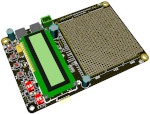
Display proto board
Prototyping board for PIC16F and PIC18F

| Speed | |||||||||||||
| FLASH | |||||||||||||
| RAM | |||||||||||||
| EEPROM | |||||||||||||
| Storage Area Flash | |||||||||||||
| I/O pins | |||||||||||||
| 8bit timers with HLT | |||||||||||||
| 16bit timers | |||||||||||||
| 16bit CCP (10bit PWM) | |||||||||||||
| 10bit PWM | |||||||||||||
| 16bit dual PWM | |||||||||||||
| Complementary Waveform Gen | |||||||||||||
| Signal Measurement Timer | |||||||||||||
| Numeric Controlled Oscillator | |||||||||||||
| Configurable Logic Cells | |||||||||||||
| 10bit ADC (ch) | |||||||||||||
| 12bit ADC (ch) | |||||||||||||
| 5bit DAC | |||||||||||||
| 8bit DAC | |||||||||||||
| Comparators | |||||||||||||
| Zero Cross Detect | |||||||||||||
| High/Low voltage detector | |||||||||||||
| Data Signal Modulator | |||||||||||||
| UART | |||||||||||||
| UART+Protocol Support | |||||||||||||
| CAN | |||||||||||||
| SPI | |||||||||||||
| I2C | |||||||||||||
| DMA | |||||||||||||
| Windowed Watchdog | |||||||||||||
| 16bit CRC | |||||||||||||
| 32bit CRC | |||||||||||||
| Vectored Interrupts | |||||||||||||
| Temperature Indicator | |||||||||||||
| JTAG Boundary Scan |
